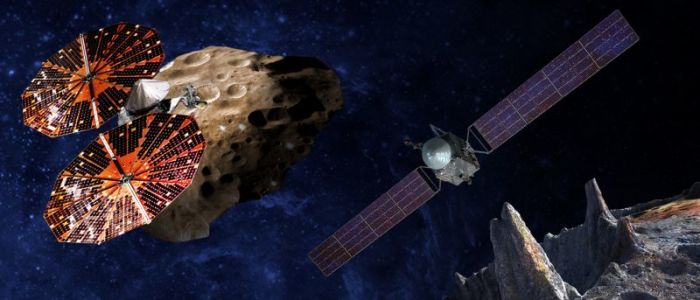NASA Announces 2 Missions to Asteroids to Explore Origins of Solar System
NASA has announced two missions in the upcoming decade which have the potential to increase our understanding of the earliest era in our solar system's history -- a time less than 10 million years after the birth of our sun.

The two unmanned missions, named Lucy and Psyche, are intended to study previously unexplored asteroids as a part of NASA's Discovery Program. The robotic missions will be launched in 2021 and 2023 respectively, a statement from the space agency said.
"Lucy will visit a target-rich environment of Jupiter's mysterious Trojan asteroids, while Psyche will study a unique metal asteroid that's never been visited before," said Thomas Zurbuchen, associate administrator for NASA's Science Mission Directorate in Washington. "This is what Discovery Program missions are all about – boldly going to places we've never been to enable groundbreaking science."
Lucy, a robotic spacecraft, is scheduled for an October 2021 launch. Its mission is to explore six Jupiter Trojan asteroids -- considered to be remnants of an earlier era in our solar system's history. Scientists believe the Trojan asteroids to be made of the same primordial material that formed the outer planets. As such, they may hold vital clues to deciphering the history of the solar system.
Lucy is slated to arrive at its first destination, a main asteroid belt, in 2025 after which it will explore the Trojan asteroids, which are trapped in the same orbit by Jupiter's gravity in two swarms, from 2027 to 2033.
While Lucy is intended to explore multiple asteroids, the Psyche mission has a singular target -- a giant metal asteroid in the main asteroid belt (located between Mars and Jupiter) known as 16 Psyche. This asteroid, a 130 miles in diameter and three times farther away from the sun than Earth, is comprised almost entirely of metallic iron and nickel. Scientists are intrigued by this as most other asteroids are rocky or icy bodies.
The similarity in composition between 16 Psyche and Earth's inner core has lead scientists to wonder if the asteroid could be an exposed core of an early planet that could have been as large as Mars, but which lost its rocky outer layers due to a number of violent collisions billions of years ago.
Related: Say Hello to Aliens - Scientists to Contact Nearest Earth-like Exoplanet
The Psyche robotic mission, with a targeted launch in October 2023 and a scheduled arrival at the asteroid in 2030, will help scientists understand how planets and other bodies separated into their layers – including cores, mantles and crusts – early in their histories.
"16 Psyche is the only known object of its kind in the solar system, and this is the only way humans will ever visit a core," said Psyche Principal Investigator Lindy Elkins-Tanton of Arizona State University in Tempe. "We learn about inner space by visiting outer space."




























